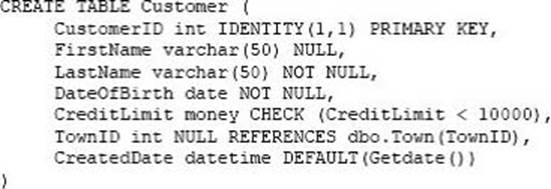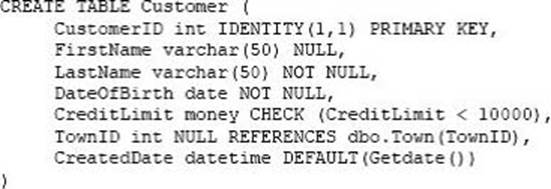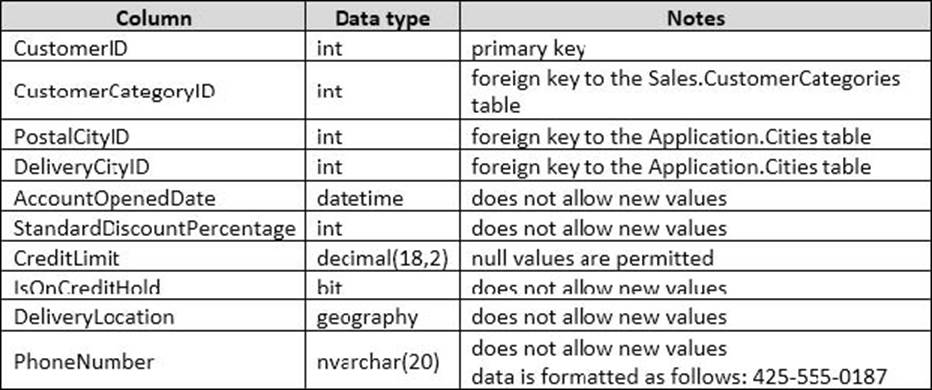Microsoft 70-761 Querying Data with Transact-SQL Online Training
Microsoft 70-761 Online Training
The questions for 70-761 were last updated at Dec 19,2024.
- Exam Code: 70-761
- Exam Name: Querying Data with Transact-SQL
- Certification Provider: Microsoft
- Latest update: Dec 19,2024
Note: This question is part of a series of questions that present the same scenario. Each question in the series contains a unique solution that might meet the stated goals. Some question sets might have more than one correct solution, while others might not have a correct solution.
After you answer a question in this section, you will NOT be able to return to it. As a result, these questions will not appear in the review screen.
You create a table named Products by running the following Transact-SQL statement:

You have the following stored procedure:

You need to modify the stored procedure to meet the following new requirements:
– Insert product records as a single unit of work.
– Return error number 51000 when a product fails to insert into the database.
– If a product record insert operation fails, the product information must not be permanently written to the database.
Solution: You run the following Transact-SQL statement:

Does the solution meet the goal?
- A . Yes
- B . No
Note: This question is part of a series of questions that present the same scenario. Each question in the series contains a unique solution that might meet the stated goals. Some question sets might have more than one correct solution, while others might not have a correct solution.
After you answer a question in this section, you will NOT be able to return to it. As a result, these questions will not appear in the review screen.
You create a table named Products by running the following Transact-SQL statement:

You have the following stored procedure:

You need to modify the stored procedure to meet the following new requirements:
– Insert product records as a single unit of work.
– Return error number 51000 when a product fails to insert into the database.
– If a product record insert operation fails, the product information must not be permanently written to the database.
Solution: You run the following Transact-SQL statement:

Does the solution meet the goal?
- A . Yes
- B . No
Note: This question is part of a series of questions that present the same scenario. Each question in the series contains a unique solution that might meet the stated goals. Some question sets might have more than one correct solution, while others might not have a correct solution.
After you answer a question in this section, you will NOT be able to return to it. As a result, these questions will not appear in the review screen.
You create a table named Products by running the following Transact-SQL statement:

You have the following stored procedure:

You need to modify the stored procedure to meet the following new requirements:
– Insert product records as a single unit of work.
– Return error number 51000 when a product fails to insert into the database.
– If a product record insert operation fails, the product information must not be permanently written to the database.
Solution: You run the following Transact-SQL statement:

Does the solution meet the goal?
- A . Yes
- B . No
Note: This question is part of a series of questions that present the same scenario. Each question in the series contains a unique solution that might meet the stated goals. Some question sets might have more than one correct solution, while others might not have a correct solution.
After you answer a question in this section, you will NOT be able to return to it. As a result, these questions will not appear in the review screen.
You create a table named Customer by running the following Transact-SQL statement:

You must insert the following data into the Customer table:

You need to ensure that both records are inserted or neither record is inserted.
Solution: You run the following Transact-SQL statement:

Does the solution meet the goal?
- A . Yes
- B . No
Note: This question is part of a series of questions that present the same scenario. Each question in the series contains a unique solution that might meet the stated goals. Some question sets might have more than one correct solution, while others might not have a correct solution.
After you answer a question in this section, you will NOT be able to return to it. As a result, these questions will not appear in the review screen.
You create a table named Customer by running the following Transact-SQL statement:

You must insert the following data into the Customer table:

You need to ensure that both records are inserted or neither record is inserted.
Solution: You run the following Transact-SQL statement:

Does the solution meet the goal?
- A . Yes
- B . No
Note: This question is part of a series of questions that present the same scenario. Each question in the series contains a unique solution that might meet the stated goals. Some question sets might have more than one correct solution, while others might not have a correct solution.
After you answer a question in this section, you will NOT be able to return to it. As a result, these questions will not appear in the review screen.
You create a table named Customer by running the following Transact-SQL statement:

You must insert the following data into the Customer table:

You need to ensure that both records are inserted or neither record is inserted.
Solution: You run the following Transact-SQL statement:
![]()
Does the solution meet the goal?
- A . Yes
- B . No
Note: This question is part of a series of questions that present the same scenario. Each question in the series contains a unique solution that might meet the stated goals. Some question sets might have more than one correct solution, while others might not have a correct solution.
After you answer a question in this section, you will NOT be able to return to it. As a result, these questions will not appear in the review screen.
You have a database that tracks orders and deliveries for customers in North America.
The database contains the following tables:
Sales.Customers

Application. Cities

Sales.CustomerCategories

The company’s development team is designing a customer directory application. The application must list customers by the area code of their phone number. The area code is defined as the first three characters of the phone number. The main page of the application will be based on an indexed view that contains the area and phone number for all customers. You need to return the area code from the PhoneNumber field.
Solution: You run the following Transact-SQL statement:

Does the solution meet the goal?
- A . Yes
- B . No
Note: This question is part of a series of questions that present the same scenario. Each question in the series contains a unique solution that might meet the stated goals. Some question sets might have more than one correct solution, while others might not have a correct solution.
After you answer a question in this section, you will NOT be able to return to it. As a result, these questions will not appear in the review screen.
You have a database that tracks orders and deliveries for customers in North America. The database contains the following tables:
Sales.Customers

Application.Cities

Sales.CustomerCategories

The company’s development team is designing a customer directory application. The application must list customers by the area code of their phone number. The area code is defined as the first three characters of the phone number.
The main page of the application will be based on an indexed view that contains the area and phone number for all customers.
You need to return the area code from the PhoneNumber field.
Solution: You run the following Transact-SQL statement:

Does the solution meet the goal?
- A . Yes
- B . No
Note: This question is part of a series of questions that present the same scenario. Each question in the series contains a unique solution that might meet the stated goals. Some question sets might have more than one correct solution, while others might not have a correct solution.
After you answer a question in this section, you will NOT be able to return to it. As a result, these questions will not appear in the review screen.
You have a database that tracks orders and deliveries for customers in North America.
The database contains the following tables:
Sales.Customers

Application. Cities

Sales. CustomerCatagories

The company’s development team is designing a customer directory application. The application must list
customers by the area code of their phone number. The area code is defined as the first three characters
of the phone number. The main page of the application will be based on an indexed view that contains the area and phone number for all customers.
You need to return the area code from the PhoneNumber field.
Solution: You run the following Transact-SQL statement:

Does the solution meet the goal?
- A . Yes
- B . No
Note: This question is part of a series of questions that use the same scenario. For your convenience, the scenario is repeated in each question. Each question presents a different goal and answer choices, but the text of the scenario is exactly the same in each question in this series.
You query a database that includes two tables: Project and Task.
The Project table includes the following columns:

The Task table includes the following columns:

You plan to run the following query to update tasks that are not yet started:
UPDATE Task SET StartTime = GETDATE () WHERE StartTime IS NULL
You need to return the total count of tasks that are impacted by this UPDATE operation, but are not
associated with a project.
What set of Transact-SQL statements should you run?
A)
![]()
B)

C)
![]()
D)
![]()
- A . Option A
- B . Option B
- C . Option C
- D . Option D
Latest 70-761 Dumps Valid Version with 212 Q&As
Latest And Valid Q&A | Instant Download | Once Fail, Full Refund

